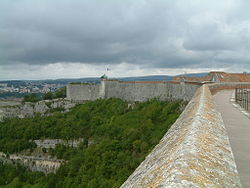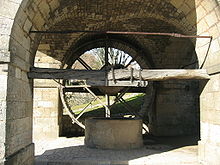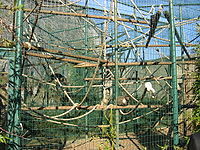- Citadel of Besançon
-
Citadelle of Besançon 
The citadelle, from the skyGeneral information Town or city Besançon Country France Coordinates 47°13′46″N 6°02′05″E / 47.2294°N 6.0346°ECoordinates: 47°13′46″N 6°02′05″E / 47.2294°N 6.0346°E Construction started 1668 Technical details Size 11 ha Design and construction Client City of Besançon Owner City of Besançon Architect Vauban The Citadel of Besançon in Franche-Comté, France, is one of the military architect Vauban's masterpieces. The Citadel occupies eleven hectares on Mount Saint-Etienne, one of the seven hills that protect Besançon, the capital of Franche-Comté. Mount Saint-Etienne occupies the neck of an ox-bow formed by the river Doubs, giving the site a strategic importance that Julius Caesar recognized as early as 58 BC. The Citadel overlooks the old quarter of the city, which is located within the ox-bow, and offers a magnificent view of the entire city and its surroundings.
The fortification is well preserved. Today it is an important tourist site (over a quarter of a million visitors per year) due both to its own characteristics and because it is the site of several museums. These museums include a museum of the Resistance and deportation, a museum focusing on traditional life in Franche-Comté and the region's archeological history, and a museum of natural history that includes a zoo, an insectarium, an aquarium, vivariums, a noctarium, a climatorium, a pedagogical exhibit on evolution, botanical gardens, and a children's farm. There is also a restaurant and shops.
On July 7, 2008, UNESCO listed the Citadel, together with nearby Fort Griffon, as a World Heritage Site. Since 1942, the French Ministry of Culture has listed the Citadel as a Monument historique.[1]
Contents
History
Construction (1668-1711)
The Treaty of Nijmegen in 1678 gave the region of Franche-Comté to Louis XIV, who decided to improve significantly the city of Besançon's defenses. In March 1668 Louis appointed the military architect Vauban to design the Citadel. The initial construction, which took place under the supervision of Ambrose Precipiano, took six years. Work continued over thirty years with the result that by 1711, the Citadel was one of the strongest fortifications of the period. The construction was so expensive that - so the story goes - the king asked Vauban if he was building the walls of gold.
Military architecture
The Citadel is built on top of a large syncline on a rectangular field crossed across its width by three successive bastions (enclosures, or fronts) behind which extend three plazas. The whole is surrounded by walls covered by circular paths and punctuated by watchtowers and sentry posts. The walls are up to 15 to 20 meters high with a thickness between 5 to 6 meters.
Vauban built the first line of defense, the Front St. Etienne, on the site of the eponymous cathedral that he destroyed in order to establish the defenses.
In front of the curtain is ready a half-moon, surrounded by ditches, equipped to the canon - the flag of entry is extended to both sides of the curtain and completed by half bastions at the ends. The curtain, which was the section of wall between the 2 half bastions, was the weak point of the wall.
A rift in the rock, which could be dry or flooded. It was bounded by the escarpment (lower slope of a ditch) and Contrescarpe (masonry wall at the end of ditch) This divide was crossed by the bridge frame, which was completed by the drawbridge. Then the 2 half bastions laterally protected access to the door. They included: - one side exposed to the enemy army and cannons - which joined the side curtain to the bastions. He could be right (as in front royal) or orillons, i.e. sheltered behind a corner covering artillery stationed on the flank. The same system on the front orillons Saint-Etienne. Finally, two ties were arranged on each side of buildings to protect views and firing from the side hills and Chaudanne Bregille.
So this system was constructed so that for all positions, we could monitor the enemy wherever he is and he was so identified. Even if there were an enemy to the aplomb of a wall, rather than risking to look to achieve, you could touch from another post. In fact, all the shots and angles of view were studied to better defend the defensive system.
Then, to get to Front Royal, there was a large sloping grassy area, which forms the glacis. This allowed glacis, where the Front St. Etienne is crossed, to see the enemy coming and to anticipate any attack. Formerly, he was on naked and without trees. At the extreme left along the cliff, an underpass allowing front of the first defenders to retreat to the front royal. The Front Royal is flanked by two boxes of surveillance: the tower of the king and the tower of the queen. The front and the Front Royal Relief (at the other end of the Citadel) was built by the Spanish and edited by Vauban.
These fronts are linked by two huge walls, who married almost perfect topography and rock. The walls are made of limestone, and are 5 to 6 m thick and 15 to 20 m high. Vauban intended the walls to screen the Citadel's precincts from the view of any enemy occupying the surrounding hills.
The upper part of the parapet was built in brick because their chips were much less deadly than the limestone. These walls define the inner courtyard, and were surmounted by a walkway on which you could walk up to the guard. Over ten sentry posts lined the walls, of which only one or two survive. These sentry posts were of limited use in combat at they were fragile.
Other buildings
The courtyard contains several buildings. At the center is a school for cadets, built in 1682 on the orders of Louvois, minister of the Sun King. A court divides the building into two parts. One part was a barracks that housed up to 600 cadets. The other part is the school. In terms of its architecture, the fire is divided over its entire length by a thick wall that put the occupants to escape the shooting side.
Built fortified against the wall, away from enemy fire, the powder magazine: building for the conservation of barrels of powder, especially protected and strengthened to prevent the potential of ignition in fire and explosion hazards . It was built under a canopy in the open arch and "the test" (able to withstand bomb). Nails and hinges were bronze to avoid the risk of spark. It came in wooden clogs.
The arsenal was responsible for the storage, maintenance and repair of weapons. The ground floor was reserved for the gun and other gear; the first floor housed the guns, knives, ammunition.
In the seventeenth century, a system of pipes brought water to the citadel. However, this was a vulnerability as an enemy could easily destroy the pipe system at the start of a siege. Therefore, in 1692, Vauban had a well cut to a depth of 132 meters through the rock to the water table. A wheel with a diameter of four meters, operated by a man who walked within it, served to lift buckets. Unfortunately, the water turned out to be brackish and so undrinkable. Instead, the citadel relied on cisterns that stored rainwater. There was one at the front. The water was still of average quality.
The Chapel: The chapels were built by Vauban in each town for the garrison to attend the Sunday. The forms were fairly simple. There were few ornaments, except a few Doric columns. It is dedicated to Saint Stephen, in memory of the church of the same name, which was razed during the construction of the Citadel.
The buildings that Vauban undertook not randomly constructed and responded to specific needs.
The Citadel in recent times
In the following centuries, successive French governments used the Citadel as a prison or a garrison. The prisoners included the accomplices of the Voisin, accused in poisonings during the reign of Louis XIV, deserters from the armies of Louis XIV and those of Louis XV, and Royalists during the Revolution. During the First Empire the Citadel housed Austrian, French and , Spanish prisoners of war. Still, in the nineteenth century, the Citadel performed its military function when it withstood attacks by the Austrians in 1814 and the Prussians in 1871, attacks that caused little damage.
During the First World War, Besançon was sufficiently far from the front that the fighting left the Citadel untouched. Instead, its primary role was a logistical one.
During World War II the Germans captured the Citadel in 1940. Later, between 28 April 1941 and August 18, 1944 during the Occupation, German firing squads executed some one hundred resistance fighters. The fighters included eighty Frenchmen, five Spaniards, two Italians, a Luxembourgian, one Swiss and one Pole. The most painful episode occurred on Sunday 26 September 1943. The sixteen Resistance fighters who died on that day included Henri Fertet, a seventeen year old who, like Guy Môquet, wrote a poignant last letter confirming his commitment to the cause. A memorial, in the form of four stakes standing between the well and the chapel of Saint-Etienne, commemorates the "les fusilées" - the men who were shot.
After heavy fighting, the Americans captured the Citadel in 1944 and used it to hold German prisoners of war. After the Second World War, the Citadel initially served as a military depot.
Current use
In 1958, the city of Besançon acquired the site from the French government and decided to use the Citadel as a tourist site and the locus for various culture activities. Thus, it now contains several museums, both historical and scientific. The number of visitors is now approaching 300,000 per year, making the Citadel the most visited monument in the region of Franche-Comté. The following table shows the attendance figures for recent years.
Number of visitors to the citadel 2001 2002 2003 2004 2005 2006 2007 241,532 277,777 276,169 275,751 257,342 222,515 274,539 The Museum of the Resistance and Deportation
This museum, which was established in 1971 at the initiative of Denise Lorach, a former deportee, evokes the emotions and depth of this dark page of history. The museum is one of the top five in its class in France and receives an average 65,000 visitors per annum.
The museum trail is divided into twenty rooms and trafficking, with photographs, texts and original documents, the themes related to World War II: the evolution of Nazism from its inception, the War and the Vichy regime The Deportation and the Resistance inside France (Franche-Comté, Occupied Zone, Zone Libre - unoccupied - Prohibited Area, Restricted Area, Zone annexed; whole of Europe), the Liberation ... The choice of the citadel to the museum in France is symbolic because a hundred Resistants were shot during the Occupation. A memorial is dedicated to the outdoors.
Two galleries are dedicated concentration in the work of John Daligault, Nacht und Nebel deported / Night and Fog, and that of Delarbre Léon, deported resistant to Auschwitz. The collection presented for all collections of this museum in France, in large part, is a deposit The National Museum of Modern Art.
The Resource Center, accessible by appointment, provides public library, its archives, its bank of images (including 8000 negative microfilm, slides, tapes), the background sounds ... It funds interest national, made by Abbot Joseph of Martinière and Germaine Tillon records about the Ravensbrück camp with reporting, extracts or copies of studies, books and articles on camp, and various thematic issues such as the Swedish Red Cross or lesbians camp but also on sensitive issues: experience, execution, sabotage, trial ... on statistical information and data on-train convoys of 8, 11, 15 August 1944, for example. These pieces were collected and lined by file number and registered numbers of all the women deported from France, except deported Jewish-, from various sources: registers nuts prison French and German registries Ravensbrück lists of Department of Veterans Affairs, lists deported by themselves-for example revision. This fund, also result of an investigation launched by region, is supplemented by individual files containing testimonies, correspondence, poems ... The whole of this fund was deposited in 1995 by the care of Germaine Tillon at the Musée de Besançon striving to continue the work, to bring to the attention of researchers.
The Education Department, led by a teacher seconded from Education, is available for teachers to prepare for a visit or student work. it also provides writing materials, in connection with the programs of the classes of cycle 3 to the end, it also offers assistance in the preparation of the National Competition of the resistance and deportation
The Museum of Natural History
- The Course of Evolution is a pedagogic display based on collections originally established by the University of Franche-Comté.
- The Zoo holds two endangered species of big cats, the Asian lion and the Siberian Tiger, twenty species of primates, and some thirty species of exotic birds. The zoo's primary objective is the conservation and reproduction of endangered species. It also conducts research on animal behavior.
- The Insectarium, the largest in France, highlights insects, which represent 85% of world fauna.
- The Aquarium features local fish, from tiny minnows to large carp and catfish; there is also a farm breeding endangered "red foot" crayfish and aprons of the Rhone region as part of a conservation project while increasing awareness to improve their living environments.
- The Noctarium reverses day and night, and so makes it possible for visitors to watch the activities of the nocturnal mammals it contains.
- The Children's Farm provides a discovery space for children.
- The Climatorium features displays on the evolution of climate on a global and regional scale and its impact on life forms.
Heritage Identity
- The museum comtois, which has been installed since 1960 in the Front Royal, focuses on the interaction between the land and human adaptation. It highlights the art and popular traditions of Franche-Comté. Through its sixteen showrooms it describes daily life in the 19th and 20th centuries byfocusing on four main themes: food, entertainment, thought and work. The museum also has a large photographic collection of regional ethnography. Lastly, there is a model of the entire citadel.
- Space Vauban covers the era of Vauban (1638–1697), who was famous for designing impregnable fortifications. The four exhibits describe Vauban, the wars for control of the Franche-Comté, and the musketeers at the Citadel. The exhibit on Vauban in Besançon is part of the background to the classification of the city as a UNESCO World Heritage site.
A project aimed at changing the presentation in the interpretive center is now under study.
- Service Régional d'Archéologie, under the Regional Directorate of Cultural Affairs, is only accessible by appointment. This division manages the inventory of regional sites, mapping, and management of preservation efforts and planned excavations.
Notes
- ^ (French) Ministry of Culture database entry
See also
Notes and references
- This article is based on a translation of the equivalent article on the French Wikipedia
Categories:- Besançon
- Buildings and structures in Doubs
- Forts in France
- Fortified French châteaux
- Vauban fortifications in France
- Museums in Besançon
Wikimedia Foundation. 2010.
















